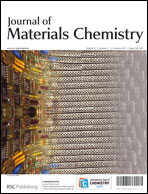Conceptual design of a three-in-one (luminescence chromophore with electron and hole transports) system was demonstrated by a functionalized Ir(III) complex 3, in which 4,5-diazafluorene and bis(diphenylamino) serve as electron and hole transporting sites, respectively. The poor emission quantum yield of 3 was systematically examined via a series of photophysical studies in combination with theoretical approaches. The far lifting of the π-electron from -NPh2 renders virtually no 3MLCT contribution to the lowest transition in the triplet manifold as compared with that of the parent model 2 without amino substituents. With an empirical approach, we conclude that an energy gap law may account for the major deactivation process. A light-emitting electrochemical cell (LEC) device based on 3 shows peak EQE, peak current efficiency and peak power efficiency at 2.4 V of 0.020%, 0.013 cd A−1 and 0.017 lm/W, respectively. The low device efficiencies are in accordance with the low PL quantum yield, stemming from the ligand-centered radiationless deactivation. The conceptual design presented here should provide valuable information for future progress en route to an ideal three-in-one system suited for OLEDs.

You have access to this article
 Please wait while we load your content...
Something went wrong. Try again?
Please wait while we load your content...
Something went wrong. Try again?


 Please wait while we load your content...
Please wait while we load your content...